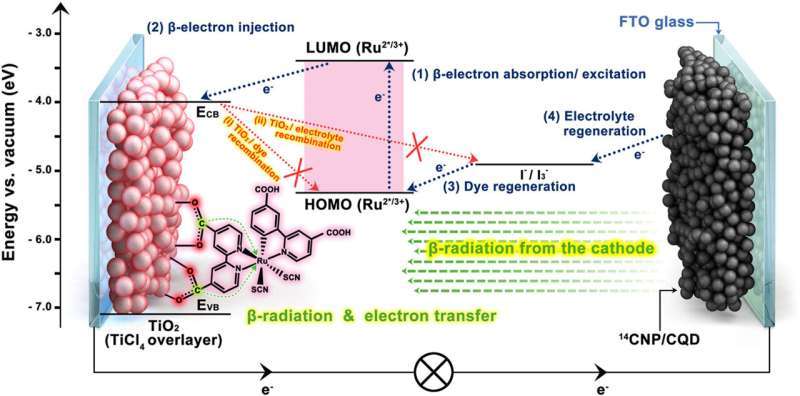
A research team has successfully developed dual-site radioactive isotope dye-sensitized betavoltaic cells, a next-generation semi-permanent battery that does not require recharging.
The research team expects that this technology will be used as one of the critical technologies for driving Korea's future growth by helping the country achieve leadership in related materials, parts, and equipment to take the lead in the market in the future across various fields, such as space, deep sea, health care, electric vehicles, and drones.
The study is published in the Journal of Power Sources.
The growth of the Fourth Industrial Revolution, represented by the Internet of Things (IoT), cyber-physical systems, and artificial intelligence (AI), is gathering momentum quickly. While this rapid growth highlights the importance of battery technology as an energy source to enable platforms, it is becoming increasingly necessary to develop next-gen batteries due to limitations with the current commercially available battery technologies, including the rising cost of raw materials such as lithium and nickel, safety issues related to heat generation and durability, and limited performance in secondary batteries.
Recently, there has been growing interest in betavoltaic cells as next-gen batteries. A betavoltaic cell is a device that generates power when beta-ray electrons emitted from radioisotopes (e.g., carbon, nickel, and hydrogen) hit a semiconductor, which is a radiation absorber. Some of the biggest advantages of betavoltaic cells are that the cells can generate power on their own without requiring external power sources and replacement, and they have a semi-permanent lifespan due to the long half-life of radioisotopes.
Furthermore, beta rays, which serve as the main energy source of betavoltaic cells, are less hazardous to the human body than gamma rays and are highly stable. Due to these advantages, many studies have been conducted on betavoltaic cells in major countries, such as the United States and China. Nonetheless, many constraints make it difficult to develop the cells, including material costs and complex manufacturing processes and technologies.
In this context, a research team led by Professor Su-il In at the Department of Energy Science and Engineering at the Daegu Gyeongbuk Institute of Science & Technology (DGIST) conducted a study to develop betavoltaic cells with price competitiveness and high efficiency. Instead of using expensive semiconductor materials as radiation absorbers in betavoltaic cells, Lee's team utilized the N719 dye, which is in the ruthenium (Ru) group, the radioisotope 14-citric acid (14CA), and titanium dioxide (TiO2).
The research team synthesized the citric acid into carbon isotope nanoparticles to increase energy density and added the citric acid between the N719 dye and titanium dioxide to form a strong bond and subsequently achieve high energy conversion and stability.
Lee's team analyzed the performance of the dual-site radioactive isotope dye-sensitized betavoltaic cells that they newly developed. The analysis confirmed that the cells generated 658,500 times more electrons than they emitted and could stably generate power for 100 hours. Compared to betavoltaic cells developed by this research team in 2020, the newly developed cells' power conversion efficiency has increased 6 times and their stability 10 times.
Professor Su-il In at DGIST said, "This study holds significance as we have successfully developed a new type of betavoltaic cell based on an inexpensive dye. We will conduct follow-up research on the mass production design and mass production of nuclear batteries to commercialize the technology in the future."
More information: Hong Soo Kim et al, Multiple-year battery based on highly efficient and stable dual-site radioactive isotope dye-sensitized betavoltaic cell, Journal of Power Sources (2024). DOI: 10.1016/j.jpowsour.2024.234427
Provided by DGIST (Daegu Gyeongbuk Institute of Science and Technology)
Citation: Researchers successfully develop next-gen semi-permanent battery technology (2024, May 20) retrieved 20 May 2024 from https://techxplore.com/news/2024-05-successfully-gen-semi-permanent-battery.html
This document is subject to copyright. Apart from any fair dealing for the purpose of private study or research, no part may be reproduced without the written permission. The content is provided for information purposes only.
